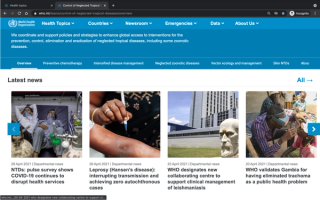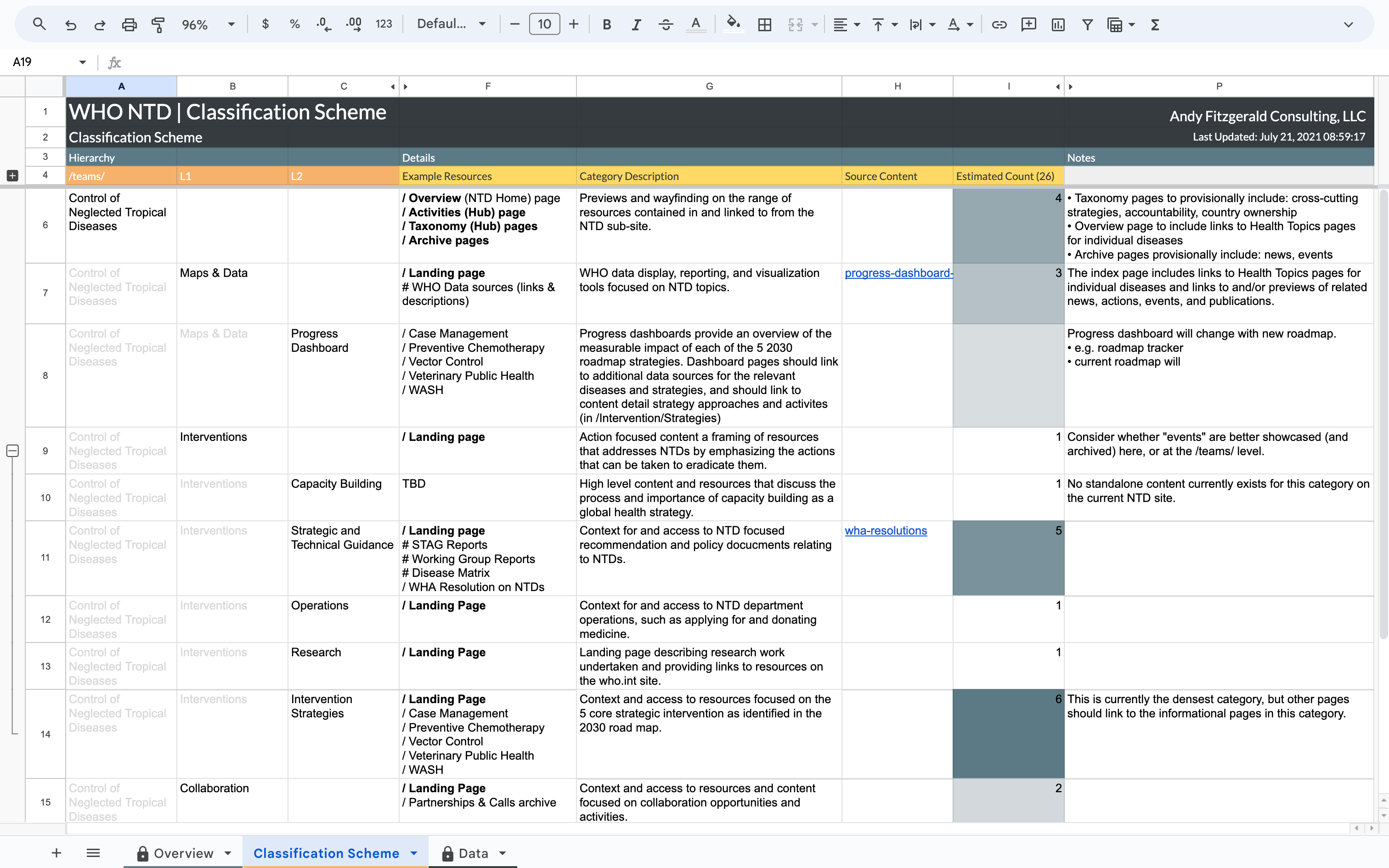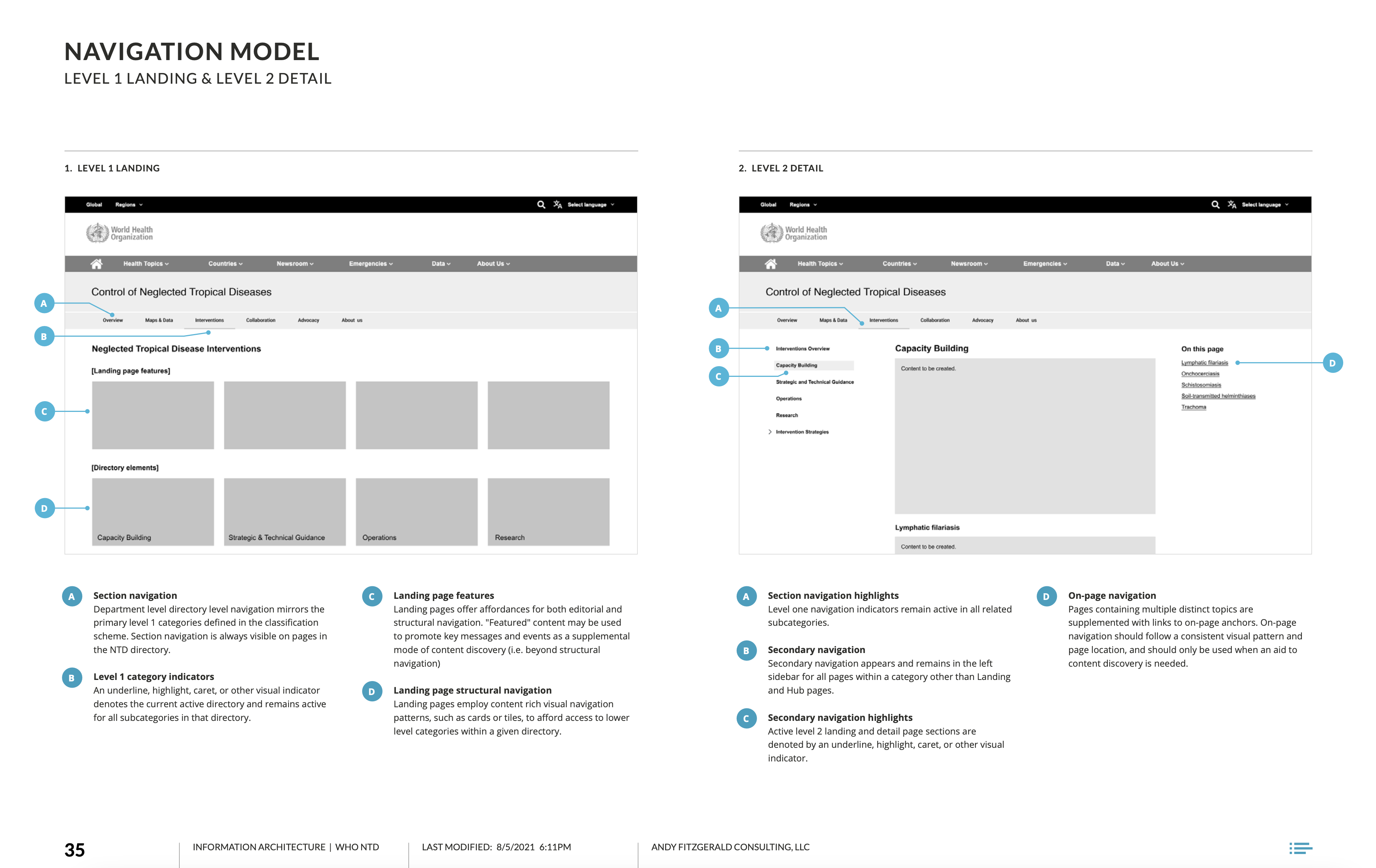
WHO Department of Neglected Tropical Diseases
I helped the World Health Organization (WHO) Department of Control of Neglected Tropical Diseases (NTD) assess and revise the information architecture of their WHO sub-site content. Where their site had previously been structured to mirror their internal organization, based on the diseases they seek to control, their content structure and navigation now reflect the information needs of key site visitors and the priorities of the NTD department.

Project Activities
- Site content and structure audit
- Performance and baseline usability audit
- Identification of user and department goals for the NTD sub-site
- Review of NTD sub-site analytics
- Design revised classification and labeling scheme
- Design revised navigation model
- Design key page type templates
Project Goal
Match Structure and Navigation to User and Organization Needs
When the WHO website was moved to a new platform as part of a site-wide update, Department of Control of Neglected Tropical Diseases (NTD) pages were migrated without evaluating or optimizing the structure, display, or overall strategy of NTD content. As a result, information resources were difficult for site visitors to find and understand, and exploring NTD content through navigation and contextually linked content was frustrating—and tended to leave a large amount of valuable content undiscovered.

Project Approach
A Two-Phase Approach to Ensure the Key Audience Needs Are Met
Because WHO NTD efforts depend on donations from governments, NGOs, and other charitable groups, ensuring easy access to information about WHO NTD news, topics, and activities is a mission-critical task for the NTD site. In order to ensure that NTD sub-site content reaches these key audiences, this project was conducted in two major phases.
Phase One: Discovery and Assessment
In the discovery and assessment phase, I met with stakeholders and subject matter experts to identify user and organization goals, and evaluated current NTD site content, structure, and performance. This created a clear and agreed-upon understanding of what content is currently available on the site, how that content is currently being used, and what goals and outcomes NTD needs site visitors to achieve. This preparatory work meant that the recommendations for improvement that follow in phase two are evidence-based and driven by a clear and shared understanding of site goals and desired outcomes.
Discovery and assessment phase tasks included:
- Site content and structure audit focused on building an accurate picture of what content is currently on and linked to from the NTD sub-site, and documenting how that content is interconnected and supported through navigation to allow discovery and use.
- Performance and baseline usability audit, focused on identifying opportunities to optimize site performance and responsiveness within the established design conventions and patterns of the larger who.int website.
- Identification of user and department goals for the NTD site including review and synthesis of department position and purpose documents, roadmap and targets documents, broader NTD domain research, and interviews with key NTD team stakeholders.
Phase Two: Classification, Labeling, Navigation, and Governance
The second, information architecture phase of this project built on the work done in discovery and assessment to deliver clear, actionable, goal-oriented recommendations for improving the findability and usefulness of NTD site content, relative to defined user and department goals.
Information architecture phase tasks included:
- Classification and labeling scheme recommendations, corresponding to the content the NTD site needs to support, the existing design constraints of the larger who.int site, and the previously identified goals of users and the department.
- Navigation model recommendations, with an emphasis on creating sub-site navigation affordances that exist in harmony with site-wide global navigation elements that were beyond the purview of this project. In this task I created recommendations for NTD specific navigation affordances that help meet user and department goals, and made recommendations for the creation and governance of metadata elements needed to make these models function effectively over time.
- Design recommendations for key page types that represent repeated information structures, such as activities, disease overview, and disease detail pages. Page types were purposefully designed as reusable templates to decrease the workload of creating new resources and strengthen the cohesiveness and regularity of the sub-site overall.
Project Outcome
Purposeful, User-Focused Sub-Site Structure, Labeling, and Navigation
The Department of Control of Neglected Tropical Diseases had always had a clear sense of its organizational mission, as well as what its web presence needed to accomplish to support that mission, but had not yet succeeded in translating this vision into a purposeful, goal-oriented website that consistently met those needs.
Through a collaborative effort of discovery and design, this project provided the NTD team with an actionable, goal-driven set of design specifications that could be implemented within the established design and technical constraints of their updated CMS.
Final recommendations included:
- An actionable, research-driven list of six annotated NTD sub-site goals
- A ranked and annotated list of five NTD sub-site user profiles, including research-driven descriptions and goals cross-referenced with NTD sub-site goals
- A ranked and annotated list of four NTD sub-site department priorities, cross-referenced with NTD sub-site goals.
- A revised content classification scheme, reflecting content organization and categorization strategies informed by user and department goals.
- A revised navigation model, focused on using existing design system affordances and constraints to help users find key information and functionality and encourage them to take desirable actions.
- A set of five reusable key page type templates, designed to support user and organization goals and structured to strengthen the cohesiveness and regularity of a site overall.



The revised WHO NTD sub-site uses purposeful, goal-driven structure, labeling, and navigation to more effectively support the information seeking behaviors of key sub-site users. It also adheres to the design conventions and patterns of the WHO's updated CMS, creating a browsing experience that is consistent with the WHO website as a whole.
